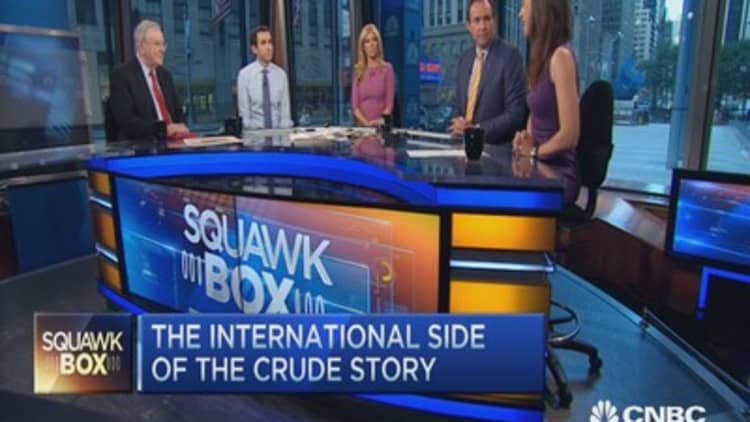
Oil supply is the biggest factor weighing on oil prices, and Iran's return to the market appears to be one of the most difficult supply sources to forecast, according to findings of a new CNBC Oil Survey.
Conducted last week, the survey of 22 top analysts and traders shows answers on when Iran is expected to return to the market to be all over the calendar. In the survey, 23 percent expect Iran to return to the market in each of the first or second quarters of 2016; another 27 percent expect it to be in the second half of 2016, and 14 percent see it happening as soon as the fourth quarter of this year. Fourteen percent say they just don't know.
Read MoreCNBC Survey: Oil prices seen below break even for frackers
Iran has said it could increase exports by a million barrels a day, but analysts have been skeptical and see it adding less output. However, Iran also has an estimated 50 million barrels of crude on tankers that could be sent to global markets quickly.
Read MoreHere's what could break the back of oil
"It's a wild card, and if it comes on six months later that's contrary to what the market thinks. I think the market expects a bump in the first half of the year. And if it ends up being later, that will have impact," said Michael Cohen, head of energy commodities research at Barclays.
Cohen said he expects Iran to bring a total 600,000 by the end of next year, starting with 200,000 by the end of this year. He notes that Iran has said it would not flood the market if the price is low.
"Iran ... I would say it's an elephant in the room. The other big elephant is U.S. production," he said. He expected the start of the decline in U.S. production to have been in July, and he expects it to drop by 50,000 to 60,000 barrels a day.
Read MoreOil collapse couldn't come at worse time for industry
"An oversupplied market is now facing a wave of ready supply. There's also as many as 50 million barrels in floating storage," said John Kilduff of Again Capital. "There's certainly disagreement over it (the timing)."
Kilduff expects to see Iran bring at least 500,000 back on the market by early 2016.
The survey also showed there are no doubts about the intentions of Saudi Arabia, which last year steered OPEC's decision to let the market set pricing, instead of output quotas. Saudi Arabia has since pumped a record amount of crude, and continues to produce at a high level.
Ninety-five percent of the participants said they do not see a meaningful production cut by Saudi Arabia this year.
It also showed the clear majority—57 percent—see supply as the most important driver of prices now, followed by the dollar, at 19 percent.
"The stunning fact is that Saudi Arabia, Iraq and the U.S. together added 2 million barrels a day to world oil supply since the price collapsed," said IHS Vice Chairman Daniel Yergin. "And this is even before Iran came back to the market."
Iran has proven highly unpredictable. Its agreement with the U.S. and five other countries to curb its nuclear program was the surprise that kicked oil lower in this latest leg down. West Texas Intermediate was trading at just above $42 per barrel Monday.
Congress is expected to vote on the Iran agreement, and the International Atomic Energy Agency will inspect Iran for compliance before sanctions will be lifted. Congress could reject the agreement but President Barack Obama is expected to override that. The question is whether Congress will have votes to overturn the veto.
"The dialogue is changing, and I don't think Congress is going to be the roadblock to the deal. They can still play a spoiling role later in time if they enact other legislation," Cohen said. But the timing on Iran's return is also going to be dictated by international inspections. "It's not a foregone conclusion that the IAEA sees compliance as 100 percent the first time,"
Participants in the CNBC survey also expect oil prices to stay lower for longer than they previously did. A majority, 62 percent, see WTI crude trading in the $30-$40 per-barrel range in September and October. However, 32 percent see prices recovering to between $50 to $60 by year end. The same number expect year-end prices at $40 to $50, while 23 percent expect prices to remain in the $30-to-$40 range.
This contrasts sharply with earlier forecasts. In a June survey, the average year-end forecast of participants was that West Texas Intermediate crude would be at $60.80 per barrel. WTI futures broke below their 2015 high last week and settled at $42.50 per barrel Friday.
Cohen sees prices bottoming though they could stay at current levels for awhile due to refinery maintenance. He said WTI could hit the $30s-a-barrel level. "We can't exclude that as a possibility, but it's not our base case forecast. We think the U.S. production declines will move us back up to a level higher than where we are right now … from a technical standpoint, the levels are right around here. We think from a chart perspective, we're kind of in oversold territory," he said.
CORRECTION: Michael Cohen is head of energy commodities research at Barclays. His title was misstated in an earlier version of this article.


